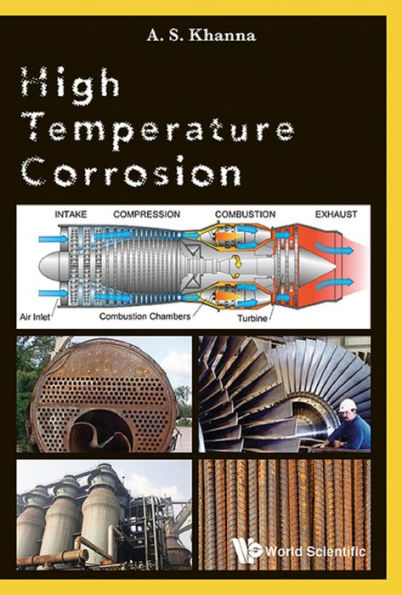Table of Contents
Foreword v
Overview xvii
Addresses of Corresponding Authors xxi
Biography xxiii
Chapter 1 Fundamentals of High Temperature Oxidation / Corrosion A.S. Khanna 1
1 Introduction 2
2 Kinetics of Oxidation 4
3 Isothermal Versus Cyclic Oxidation 6
4 Oxidation of Pure Metals 7
5 Oxidation of Alloys 10
5.1 Oxidation of Stainless Steels 11
5.2 Oxidatiou of Superalloys 13
6 Sulfidation 15
7 Hot Corrosion 20
8 Defect Structure and Diffusion 23
9 Stresses in Oxide 25
10 Active Element Effect 26
11 Selection Criteria for the Oxidation Resistant Materials for High Temperature Application 27
12 Conclusion 30
References 31
Chapter 2 Degradation of Mechanical Properties of Materials at High Temperatures in Corrosive Environments A.S. Khanna 33
1 Introduction 33
2 Creep 40
2.1 Corrosion and Creep 42
2.1.1 Positive effect of corrosion on creep 43
2.1.2 Negative effect of corrosion on creep 44
3 Fatigue 47
3.1 HTF in Corrosive Environments 49
4 Summary 54
References 55
Chapter 3 Materials Development Aiming at High Temperature Strengthening - Steels, Superalloys to ODS Alloys Shigeharu Ukai 57
1 Introduction 57
2 Heat-Resistant Ferritie Steel 58
2.1 Alloy Design 58
2.2 Materials for Fossil Power Plant 60
2.3 Advanced Ferritie Steels 63
3 Heat-Resistant Austenitic Steels 65
3.1 Alloy Design 65
3.2 Materials for Heat Exchanger and Boiler Tubes 67
3.3 Advanced Austenite, Fe-Ni; and Ni-based Alloys 70
4 Ni-based Superalloys 71
4.1 Progress for Gas Turbine and Jet Engine 71
4.2 Composition and Crystal Structure 72
4.3 Mechanical Properties 74
5 ODS Alloys 76
5.1 Fe-based ODS Steels 76
5.2 Ni-based ODS Alloys 81
6 Summary for Temperature Capability 84
References 85
Chapter 4 High Temperature Corrosion Problems in Refineries, Chemical Process Industries and Petrochemical Plants Pasi Kangas 87
1 Introduction 87
2 High Temperature Corrosion 87
3 High Temperature Materials 89
4 Some Typical Applications and Case Stories for High Temperature Materials 91
44 Petrochemical Plants 91
4.2 Ethylene Furnace Tubes 92
4.3 Lance Tubes in Steel Plant Blast Furnaces 92
4.4 Muffle Tubes in Heat Treatment Furnaces 93
4.5 Recuperator Tubes 96
References 98
Chapter 5 High Temperature Corrosion Problems in Coal-based Thermal Power Plants A.S. Khanna 99
1 Introduction 99
2 Indian Scenario of Power Generation 101
3 Types of Thermal Power Plants 102
3.1 Steam Boiler 102
3.2 Combustion Turbines 103
3.3 Combined Cycle 103
4 Corrosion in Coal-Based Power Plants 103
4.1 Fireside Corrosion 107
4.1.1 Mechanism of molten salt or slag-related attack 111
5 Fireside Erosion Problems 112
6 Steamside Corrosion Problems 116
7 Waterside Corrosion Problems 119
8 Corrosion Control Methodologies for Power Plants 120
9 Corrosion Protection Methods 121
9.1 Selection of Materials 121
10 Summary 124
References 125
Chapter 6 High Temperature Corrosion Problems in Air crafts A.S. Khanna Vinod S. Agarwala 129
1 Introduction 129
2 High Temperature Alloy Development 134
3 Oxidation and Hot-Corrosion Resistance 144
4 Failure Modes of a Turbine Blade 147
5 Protection Technology of Turbine Blades and Vanes 151
6 Future Trends 156
References 157
Chapter 7 Coatings for High Temperature Applications N. I. Jamnapara S. Mukherjee 161
1 Introduction 161
2 Issues at High Temperature 162
2.1 Oxidation 163
2.2 Sulfidation 163
2.3 Hot Corrosion 163
2.4 Erosion and Erosion Corrosion 164
2.4.1 Flyash erosion 164
2.4.2 Erosion corrosion by liquid metals 164
2.5 Carburization and Metal Dusting 164
2.5.1 Carburization 164
2.5.2 Metal dusting 165
2.6 Liquid Metal Corrosion 165
3 Requirement of Coatings 166
3.1 Basis of Coating Consideration 166
3.1.1 Metallurgical compatibility 166
3.1.2 Mechanical compatibility 166
3.1.3 Coating process compatibility 166
3.1.4 Component coatability 167
3.1.5 Environmental compatibility 167
3.1.6 Available coating database and performance data 167
3.1.7 Coating standardization 167
3.2 Types of Coating Processes 167
4 Coatings for Thermal Power and Petrochemical Plants 171
5 Coatings for Gas Turbines 174
6 Coatings for Fusion Reactors 178
6.1 Tungsten Coating for First Wall and Divertor Assembly 180
6.2 Insulator Coatings for Test Blanket Module 182
7 Coatings for Fission Reactors 186
7.1 Corrosion of Steels by Liquid Lead Bismuth Eutcetic (LBE) 186
8 Coatings for Solar Thermal Power 192
9 Conclusion 198
References 198
Chapter 8 Advanced Analytical Tools to Understand High Temperature Materials Degradation - Ion Beam Characterization of Aerospace Materials Barbara Shollock David McPhall 201
1 Introduction 201
2 Sputtering and Ion-Solid Interactions 202
3 FIB Secondary Electron and Secondary Ion Imaging 204
4 FIB-SIMS 214
References 217
Chapter 9 Role of Nanotechnology in Combating High Temperature Corrosion R.K. Singh Raman B.V. Mahesh Prabhakar Singh 219
1 Introduction 220
2 Thermal Stability and Synthesis of Nanocrystalline Materials 221
3 Oxidation Resistance of Nanocrystalline Metals/Alloys 223
3.1 General Principles 223
3.2 Oxidation Resistance of Nanocrystalline Metals/Alloys 224
4 Potential High Performance Surface Coatings 230
5 Oxidation Resistance of Bimodal Fe-Cr Alloys 234
6 Summary 237
References 238
Chapter 10 Reactive Element Additions in High Temperature Alloys and Coatings D. Naumenko W.J. Quadakkers 245
1 Introduction 245
2 The Mechanisms of the Reactive Element Effect 246
2.1 General Remarks 246
2.2 Effect of REs on Alumina Scale Microstructure and Transport Processes 246
2.3 Effect of REs on Oxide Scale Adherence 251
3 Selected Aspects of REs Use in Practical Applications 252
3.1 General Remarks 252
3.2 Chromia Forming Oxide Dispersion Strengthened (ODS) and Wrought Alloys 253
3.3 Reactive Element Reservoir in FeCrAl-Alloys 255
3.4 Interaction of REs with C and N Impurities 257
3.5 RE-Effects in Alumina Forming Coatings 259
4 Conclusions 263
References 264
Index 269



